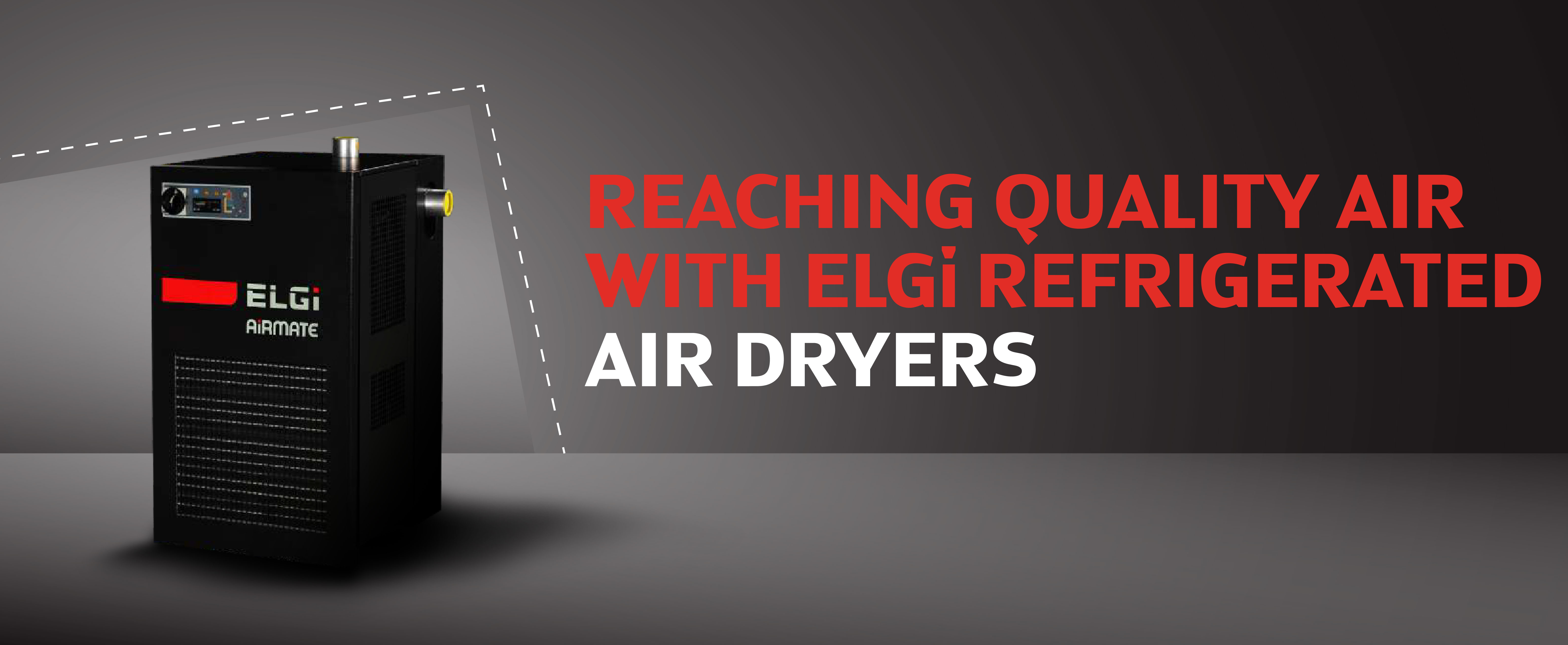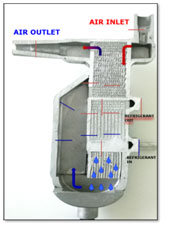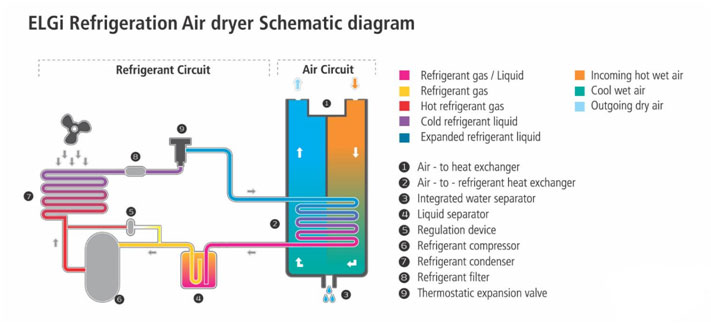REACHING QUALITY AIR WITH ELGi REFRIGERATED DRYERS

Why Is Dry Air Needed?
In nearly all compressed-air applications, a certain degree of air quality is required. Air quality can be described as a measure of how clean and how dry the compressed output air is or is required to be. A significant measurable portion of air quality is the moisture level in the compressed air, where the goal is to reduce the moisture in the air as much as possible by drying the air. The reason a low air moisture level is required has to do with the user's equipment and tools that compressed air is used to operate. This moisture can damage or affect the operation of your equipment and tools, and any damage or interference caused to these items can result in expensive repairs or equipment replacement. Situations like this result in downtime, eating into their bottom line.

Why Do Dryers Fail?
A dryer's ability to dry compressed air is limited by its capacity to handle the total output or airflow of compressed air. This capacity rating is affected by several environmental factors: ambient air temperature, compressed air temperature, and inlet air pressure. Any change in these factors can improve or reduce the dryer's ability to handle the capacity of airflow. If a dryer is subjected to increased air temperature and other poor conditions, the dryer will overwork to maintain air dryness. This is called overloading a dryer. An overloaded dryer is unable to cycle as required, causing potential damage to dryer components. Outside of environmental factors, there are considerations regarding the air quality such asexcess particulate and contaminant presence in the compressed air can accumulate inside the air dryer, constricting its ability to allow or process airflow and preventing the dryer from efficiently drying the compressed air. Installing a pre-stage particulate filter in line with the dryer can help protect from damage and flow restrictions.

How To Spot If Your Dryer Isn’t Working?
Keeping in mind the purpose of a compressed air dryer, the quickest sign that your dryer is not functioning is the presence of water downstream of the dryer. Inspecting low points such as drains, filter bowls, drip legs, and the output air at the application can reveal an inadequate amount of air drying. While it may appear that your dryer is functioning correctly, via its gauge or meter displaying moisture dewpoint level, it is wise to keep in mind the current temp and humidity of the air while inspecting your dryer. The capacity requirement to dry the air can be significantly reduced if the temperature and humidity level in the environment is low, giving the impression that the dryer is functioning fine and not highlighting potential issues. This is how dryer failures can appear seasonal, causing dryer failures to be common in the summer as winter temperatures and humidity are typically much lower.
When To Repair or Replace?
Due to the nature of the design of refrigerated compressed air dryers, making repairs to this dryer type requires specific technical skills such as the ability to solder lines, knowledge of refrigerants, and knowledge of using a gauge set to measure charge. These skills are needed for making critical repairs due to the internal refrigerant compressor and circuit that comprises the dryer's system that allows it to process out moisture in compressed air. Start with analyzing your initial cost investment, ensuring to include both dryer price and installation cost. From there, get a quote for replacement parts and repair time. Weigh the availability and lead time of a new replacement dryer and consider if it is worth your downtime to have your current dryer repaired. Keep in mind that there is also the carried risk of inadequate repairs and mistakes furthering your potential downtime. It may sometimes be the case that it will make better logical and financial sense to have your dryer replaced outright for a faster uptime instead of awaiting a technician's response and repairs to your existing refrigerated air dryer.

Why choose the EGRD Dryer?
ELGi offers a line of non-cycling refrigerated compressed air dryers in the EGRD Series product within ELGi's AIRMATE accessories line. The EGRD Series ranges from 10 CFM to 10,000 CFM with multiple input voltage types, all in a space-friendly, service-friendly, and compact frame size available to US and Canadian markets. The design of the EGRD AIRMATE dryer allows for many benefits, including low dewpoint fluctuations, low-pressure drop (loss) across inlet/outlet, and robust components to ensure great durability! To accomplish efficient drying drop, the EGRD series dryers use a hot gas bypass design that alleviates the extraneous load on the dryer's compressor. Alongside this, to achieve low-pressure drop, the heat exchanger is oversized for each dryer CFM size. To ensure that our dryer line is suitable for dryer replacement applications, effort has been made to reduce the footprint of the dryer to allow it to be compatible with many industrial applications. ELGi offers these dryers a one-year full dryer package warranty, warrantying the heat exchanger for three years as long as an AIRMATE prefilter assembly is ordered alongside the dryer upon purchase. EGRD series dryers are competitively priced to the market, offer a great value compared to other options, and are dryers are kept in stock in ELGi USA warehouses from 10 – 500 CFM for faster order turnarounds for popular models!

Don’t hesitate to reach out to the ELGi team to request more information on how to ensure your required air quality is being met!
If you require service or repairs,ELGi has a wide service network across North America readily available to help you with any dryer service requirements. To find the nearest provider, visit https://www.elgi.com/us/distributors/

